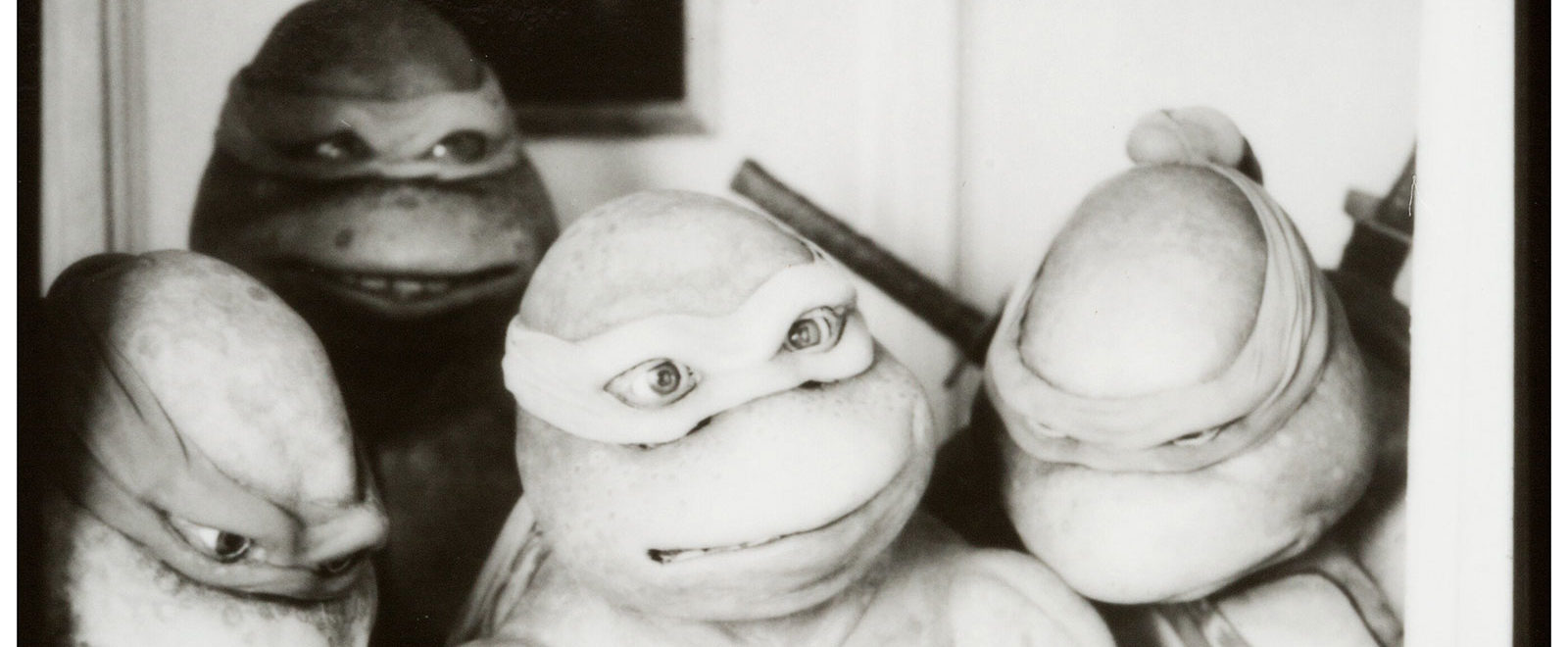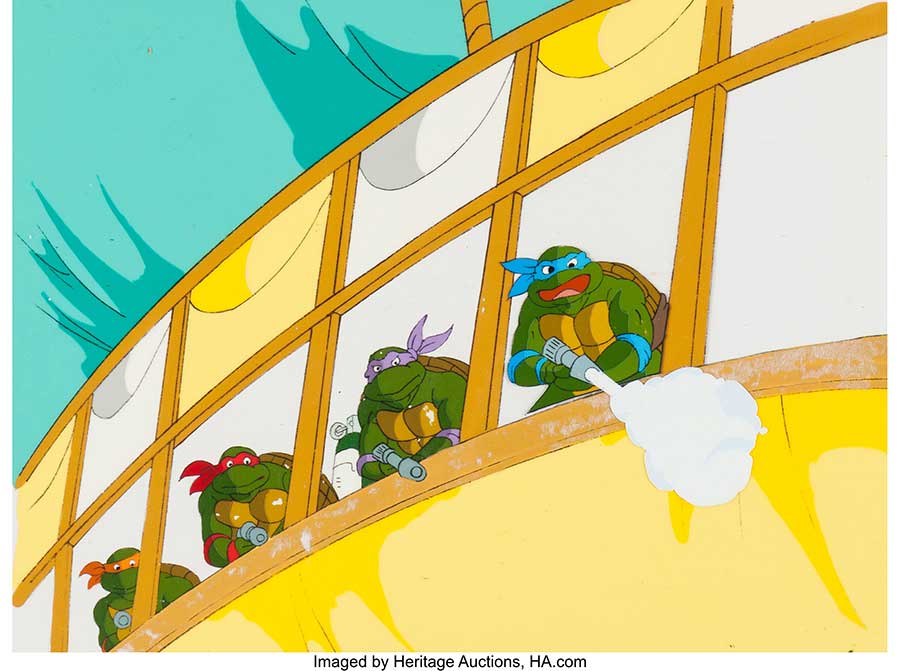MARK FREEDMAN, THE SAVVY LICENSING AGENT WHO LED THE TEENAGE MUTANT NINJA TURTLES TO GLOBAL STARDOM, OPENS HIS ‘TMNT’ VAULT
By Rhonda Reinhart
EVENT
MARK “THE FIFTH TURTLE” FREEDMAN SHOWCASE AUCTION 44162
Feb. 3, 2022
Online: HA.com/44162a
INQUIRIES
Ed Jaster
214.409.1288
EdJ@HA.com
Valarie McLeckie
214.409.1994
ValarieM@HA.com
When Mark Freedman first heard about Teenage Mutant Ninja Turtles – the self-published black-and-white comic book created in 1984 by Kevin Eastman and Peter Laird – the title alone had him intrigued. “I thought the name was impossibly clever,” he says. “It was just a crazy-sounding title, and I had to know more.”
At that time, in 1986, Freedman had already gained 10 years of experience in the toy industry, at one point working under Stanley Weston, who created the G.I. Joe toy line and is credited with inventing the very concept of action figures. Freedman was also the founder of the fledgling licensing company Surge Licensing, and he was on the hunt for an emerging brand he could shepherd. As it turns out, Teenage Mutant Ninja Turtles – about four crime-fighting, sewer-dwelling reptile brothers named Raphael, Michelangelo, Donatello and Leonardo – was just what he’d been looking for.
“What I saw in the first comic was great storytelling. Eastman and Laird spun a story that was just incredible. That’s what set my brain into a bit of a spin in terms of excitement,” he says. “And the characters would align themselves perfectly with action figures. It was a blueprint for a toy line. Eastman and Laird unwittingly created the brand architecture for toys without knowing anything about the toy business. I was sold pretty much the second I saw it.”
Once the three men joined forces, however, toys were just the beginning for the soon-to-skyrocket Turtles franchise. By 1987, a TMNT cartoon was airing on television screens across America, bringing the Heroes in a Half Shell to a whole new – and younger – audience. “We had our show on every day, and that’s what really propelled the toys to the stratosphere,” Freedman says. “The show took off, and that’s when we knew we were off to the races.”
After the cartoon came a video game, which was followed by a live-action, record-breaking motion picture. Released in 1990, Teenage Mutant Ninja Turtles the movie raked in $135 million at the domestic box office, making it the highest-grossing independent film of all time at that point. Upon the movie’s success, Turtles toys experienced another explosion, selling 100 million units in 1990 alone. Soon, the likenesses of Leonardo, Raphael, Michelangelo and Donatello could be found on products of all kinds, from lunchboxes, pinatas and pinball games to roller skates, skateboards and snow skis.
For the past 35 years, Freedman – nicknamed “The Fifth Turtle” for his decades-long dedication to the four unlikely heroes – has held onto examples of all of this Turtles merch, as well as original TMNT comics, prototypes that never made it into production and a variety of products manufactured exclusively for international markets. The items represent more than three decades of memories and symbolize the work that went into turning an obscure comic book into a pop-culture phenomenon.
But, as Freedman says, “sometimes you have to purge a little bit.” Which is why, on Feb. 3, Heritage Auctions will proudly present Mark “The Fifth Turtle” Freedman Showcase Auction, featuring more than 200 lots from Freedman’s personal collection of TMNT treasures.
Auction highlights include a selection of unopened, vintage video games such as a sealed copy of 1989’s Teenage Mutant Ninja Turtles for the Nintendo Entertainment System, which features the first appearance of the Turtles in a home console video game. Carrying a Wata grade of 9.8 A++, this game is the highest-graded copy of Teenage Mutant Ninja Turtles for the NES that Heritage has ever offered. The sale also features a sealed copy of 1994’s Teenage Mutant Ninja Turtles: Tournament Fighters, which has long been considered one of the rarest NES games in the Turtles franchise – if not the rarest. This game also has a Wata grade of 9.8 A++, which is effectively the highest grade one could hope to receive from Wata, and it’s only the third factory-sealed example ever offered in a Heritage auction.
Another coveted collector’s item in the sale is the world-premiere Teenage Mutant Ninja Turtles pinball game machine from 1991. A production model, the machine was exclusively displayed at retail conventions and includes an attached “World Premiere” plaque. Collectors will also clamor for a binder filled with contact sheets from the 1990 TMNT movie. The album, which Freedman says not only rekindled fond memories of making the film but also “brought a little bit of a tear to my eye,” includes a variety of black-and-white shots of various characters and scenes from the movie.
But it’s the toys in the sale that Freedman considers the most special. “I’m a toy guy at heart, and being able to turn your idea or inspiration into an actual action figure is the ultimate high in the toy industry,” he says. “And having it be successful is the second. It’s not an easy thing to accomplish.”
As Freedman already knew, building a global brand requires hard work in the best of circumstances, but when the property you’re trying to promote stars four martial artist turtles who are also teenage mutants, you have an even bigger battle on your hands.
“No one really understood it,” he says, recalling his many TMNT pitches to the usual-suspect toy companies. “I was turned down everywhere. Everyone said no except for this one toy company called Playmates, and no one had ever heard of Playmates. But when I brought them Ninja Turtles they immediately got it.”
Admittedly, the Turtles weren’t the typical toy heroes. They had no superpowers, for one thing, and beyond that, they had human foibles and tastes, including a particular fondness for pizza. “They weren’t necessarily the strongest but had to work as a team to overcome adversity,” Freedman says of the Turtles.
But he just as easily could be talking about the Surge Licensing-Playmates partnership. While both teams started out as underdogs, they put their all into the Turtles, eventually transforming TMNT into a multibillion-dollar property that lives on today. In 2008, Viacom (owner of Nickelodeon) bought the Turtles franchise, reimagining the brand in a variety of ways. The Turtles’ future looks bright, too: In 2023, Seth Rogen’s production company Point Grey Pictures, alongside Nickelodeon Animation Studios, is set to release a CG-animated movie starring Michelangelo, Donatello, Leonardo and Raphael.
And it’s all because an up-and-coming licensing agent saw the potential in an underground comic book and was hopelessly devoted to it from day one. “This was a labor of love. I put my heart and soul into it,” Freedman says. “There were days and days when I didn’t sleep. It was that kind of an effort to make this happen.”
But happen it did because, as the world would soon discover, you can’t keep a good Turtle down, not even an honorary fifth one. Now generations of fans – and generations to come – can enjoy the lovable heroes who, to some, didn’t make much sense but, to countless others, made all the sense in the world.
 RHONDA REINHART is editor of Intelligent Collector.
RHONDA REINHART is editor of Intelligent Collector.



![Teenage Mutant Ninja Turtles - Wata 9.8 A++ Sealed [Oval SOQ TM] (Mark Freedman File Copy), NES Ultra 1989 USA](https://intelligentcollector.com/wp-content/uploads/2021/12/Teenage-Mutant-Ninja-Turtles-Wata-9.8-A-Sealed-Oval-SOQ-TM-Mark-Freedman-File-Copy-NES-Ultra-1989-USA.jpg)

